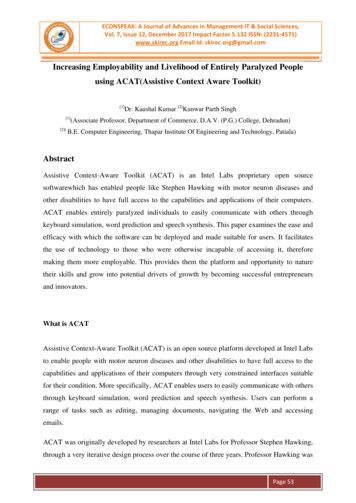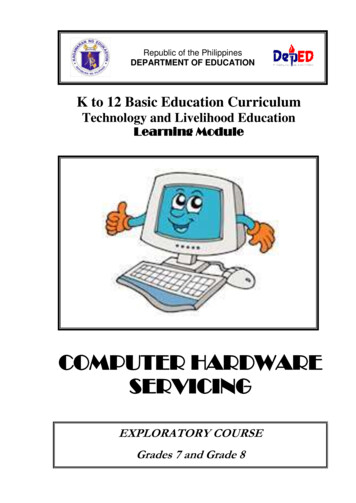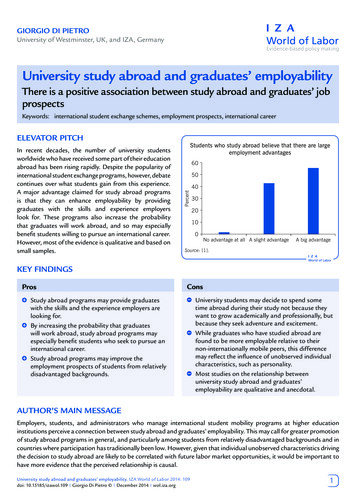
Transcription
ECONSPEAK: A Journal of Advances in Management IT & Social Sciences,Vol. 7, Issue 12, December 2017 Impact Factor 5.132 ISSN: (2231-4571)www.skirec.org Email Id: skirec.org@gmail.comIncreasing Employability and Livelihood of Entirely Paralyzed Peopleusing ACAT(Assistive Context Aware Toolkit)[1]Dr. Kaushal Kumar [2]Kunwar Parth Singh[1](Associate Professor, Department of Commerce, D.A.V. (P.G.) College, Dehradun)[2](B.E. Computer Engineering, Thapar Institute Of Engineering and Technology, Patiala)AbstractAssistive Context-Aware Toolkit (ACAT) is an Intel Labs proprietary open sourcesoftwarewhich has enabled people like Stephen Hawking with motor neuron diseases andother disabilities to have full access to the capabilities and applications of their computers.ACAT enables entirely paralyzed individuals to easily communicate with others throughkeyboard simulation, word prediction and speech synthesis. This paper examines the ease andefficacy with which the software can be deployed and made suitable for users. It facilitatesthe use of technology to those who were otherwise incapable of accessing it, thereforemaking them more employable. This provides them the platform and opportunity to naturetheir skills and grow into potential drivers of growth by becoming successful entrepreneursand innovators.What is ACATAssistive Context-Aware Toolkit (ACAT) is an open source platform developed at Intel Labsto enable people with motor neuron diseases and other disabilities to have full access to thecapabilities and applications of their computers through very constrained interfaces suitablefor their condition. More specifically, ACAT enables users to easily communicate with othersthrough keyboard simulation, word prediction and speech synthesis. Users can perform arange of tasks such as editing, managing documents, navigating the Web and accessingemails.ACAT was originally developed by researchers at Intel Labs for Professor Stephen Hawking,through a very iterative design process over the course of three years. Professor Hawking wasPage 53
ECONSPEAK: A Journal of Advances in Management IT & Social Sciences,Vol. 7, Issue 12, December 2017 Impact Factor 5.132 ISSN: (2231-4571)www.skirec.org Email Id: skirec.org@gmail.cominstrumental to the design process and was a key contributor to the project design andvalidation. After Intel deployed the system to Professor Hawking, we turned our attention tothe larger community and continued to make ACAT more configurable to support a larger setof users with different conditions.Our hope is that, by open sourcing this configurable platform, developers will continue toexpand on this system by adding new user interfaces, new sensing modalities, wordprediction and many other features. ACAT is designed to run on Microsoft Windows*machines and can interface to different sensor inputs such as infrared switches, camera, pushbuttons, and more.ACAT is available in English, French, Spanish and Portuguese.With the help of theuser/developer community, Intel is working on extending it to other languages.ACAT is useful for Microsoft Windows developers who are interested in developing assistivetechnologies to people with ALS or similar disabilities. Also for researchers who are workingon new user interfaces, new sensing modalities or word prediction and wanting to explorethese innovations in the this communityStephen Hawking and IntelThe software used to help Stephen Hawking communicate with the world has been madeavailable by Intel for free online in the hopes it can help other people with similar disabilities.Hawking, 73, who has a motor neuron disease and is almost entirely paralyzed, relies on thetechnology to speak. His speech system got an upgrade from Intel last year, allowing him totype faster, browse the Internet much easier and seamlessly switch between tasks.The hope is the code for that software, called Assistive Context-Aware Toolkit (ACAT),will be leveraged by developers who are running Microsoft Windows 7 or higher to createnew interfaces that could help people with ALS, Lou Gehrig‟s disease, spinal cord injuriesand other disabilities communicate with the world.Page 54
ECONSPEAK: A Journal of Advances in Management IT & Social Sciences,Vol. 7, Issue 12, December 2017 Impact Factor 5.132 ISSN: (2231-4571)www.skirec.org Email Id: skirec.org@gmail.comIn Hawking‟s case, his cheek sensor syncs with a switch on his glasses, allowing him tochoose characters he wishes to type, which can then be processed by his speech synthesizerand spoken out loud from his laptop.It also allows the cosmologist to use various computer programs and navigate the Internet.Intel said last year it was able to increase the efficiency of Hawking‟s system by integratingpredictive text technology. The software knows Hawking‟s communication patterns, meaninghe has to type less than 20 percent of all characters to convey what he wants to say.Bymaking the program open source, Intel said it hopes developers will be able to experimentand expand on the system by creating new interfaces and ways for sensors to connect with thesystem.Motivation On Selecting The TopicACAT is a technology that can help millions of people if it is implemented at a large scale.Itgives a kind of new life to a paralyzed person as he can talk and respond to actions which hecannot do earlier.If this technology is made available to a greater population with disabilities limiting themfrom communicating or using the computer or the internet, it could greatly change thescenario. We are lucky to have this technology in an era of personal computers where it canbe used properly.Intel has Open-Sourced the ACAT software so that users can try the software and they cantwerk the software according to their needs or provide necessary changes to the software sothat more and more people can benefit from the software.It is highly customizable according to the user‟s needs so that every paralyzed patient cantake full advantage of this technology, by modifying the software according to their disabilityPage 55
ECONSPEAK: A Journal of Advances in Management IT & Social Sciences,Vol. 7, Issue 12, December 2017 Impact Factor 5.132 ISSN: (2231-4571)www.skirec.org Email Id: skirec.org@gmail.comTechnical Details1. ACAT( Assistive Context-Aware Toolkit) runs only onWindows 7 or higher2. Written on Visual Studio 2012 or higher3. Coded entirely in C#4. Uses Microsoft .NET Framework 4.55. Microsoft Office Interop Assemblies are used to interact with Office apps6. Bundled with Visual Studio Professional/Premium/Ultimate7. Optional Visual Studio Add-ons8. StyleCop (free) to enforce .NET coding standards9. CodeMaid (free) to cleanup/reorganize the code10. ReSharper (paid) to optimize the codePage 56
ECONSPEAK: A Journal of Advances in Management IT & Social Sciences,Vol. 7, Issue 12, December 2017 Impact Factor 5.132 ISSN: (2231-4571)www.skirec.org Email Id: skirec.org@gmail.comACAT ArchitectureThe ACAT model consists of two major libraries:- ACAT Core Library ACAT Extensions LibraryThere is a user side interface called the Applications, through which the user interacts withthe system and the two libraries.Page 57
ECONSPEAK: A Journal of Advances in Management IT & Social Sciences,Vol. 7, Issue 12, December 2017 Impact Factor 5.132 ISSN: (2231-4571)www.skirec.org Email Id: skirec.org@gmail.comApplicationsPage 58
ECONSPEAK: A Journal of Advances in Management IT & Social Sciences,Vol. 7, Issue 12, December 2017 Impact Factor 5.132 ISSN: (2231-4571)www.skirec.org Email Id: skirec.org@gmail.comACAT Core LibraryThe ACAT Core library is a single DLL that provides all the core services. Figure shows thecomponents that make up the Core library.Panel ManagementAll the scanners, dialogs and menus are also extensions. The word Panel is used to denote ascanner, a dialog or a menu. ACAT uses the Window stacking model to display panels. Thelook and feel of panels can be configured through Panel config files and the preferred panelsto display can also be configured. The Panel Manager in this component is responsible forenumerating panels, handling requests to display them, maintaining the stack of active panels,activating and deactivating them.Animation ManagerThe Animation Manager in this component is responsible for loading animation files whichcontain the scanning sequence for scanners, executing the scanning process and handlingtransitions between scanning sequences.Page 59
ECONSPEAK: A Journal of Advances in Management IT & Social Sciences,Vol. 7, Issue 12, December 2017 Impact Factor 5.132 ISSN: (2231-4571)www.skirec.org Email Id: skirec.org@gmail.comWidget ManagementA widget is a wrapper class around the controls in a scanner. It contains additional attributescontrolling the appearance and behavior such as fonts, colors and text. The Widget Managerin this component reads the attributes for the active scanner, instantiates the widget objectsfor the elements in the scanner and also controls the appearance of the scanner elementsduring scanning.Word Predictor ManagementNext-word prediction during text entry is one of the key features of ACAT. The WordPrediction Manager in this component enumerates installed Word prediction extensions, andactivates and configures the preferred Word prediction extension.Theme ManagementACAT supports color schemes for the scanners, dialogs and menus. The Theme Manager inthis component enumerates and manages installed themes.Page 60
ECONSPEAK: A Journal of Advances in Management IT & Social Sciences,Vol. 7, Issue 12, December 2017 Impact Factor 5.132 ISSN: (2231-4571)www.skirec.org Email Id: skirec.org@gmail.comACAT Extension LibraryThe ACAT Extension Library has helped classes and base classes for the development ofPanels and Agents.Just like the core library, the extension library comprises of sections ofvarious independent extensions ;all working in synchronization with the system.Application Agent Base ClassesThe base classes for Application agents do most of the heavy lifting required to supportapplications such as Notepad, Microsoft Word, and Internet Explorer, etc. This makes iteasier to derive and extend the functionality provided by the base classes.Command HandlersACAT supports a host of „commands‟, strings that represent action verbs Examples ofcommands are CmdTalkWindowToggle to toggle the visibility of the Talk window,CmdMainMenu to display the Main menu. These commands can be attached to events suchas actuating an element on a scanner or to input switches. The Extension library has defaulthandlers for various commands. See Chapter 14 for details on Command Handlers.Page 61
ECONSPEAK: A Journal of Advances in Management IT & Social Sciences,Vol. 7, Issue 12, December 2017 Impact Factor 5.132 ISSN: (2231-4571)www.skirec.org Email Id: skirec.org@gmail.comUtility ClassesThe Extension library has a number of utility/helper classes to display dialogs, load/storeACAT settings ,etc.Page 62
ECONSPEAK: A Journal of Advances in Management IT & Social Sciences,Vol. 7, Issue 12, December 2017 Impact Factor 5.132 ISSN: (2231-4571)www.skirec.org Email Id: skirec.org@gmail.comActuatorsActuators are input trigger mechanism which are translated into actions. They are used todrive the UI.Each Actuators is an ACAT Extension which is composed of Switches. ACATactions are mapped to each switch which are associated with an event.Actuators interfacewith the underlying hardware.-E.g. Left and right mouse buttons are two switches on a mouse.For gesture input, each gesture can be treated as a SwitchACAT has helper classes to interface with1. -USB HID Devices2. -TCP/IP Servers/ClientsSupport included for facial gesture recognition, proximity sensor, accelerometer ring 32.The following switch mechanisms are supported by ACAT: Keyboard: The function key F12 is the default key to trigger ACAT. Every time theuser hits F12, the scanner will respond by executing the action associated with thehighlighted element. You can change the default key through the ACAT Configutility. Refer to the ACAT User Guide or to the ACAT FAQ for details. ACAT Vision: ACAT vision application uses a webcam to detect facial gestureswhich are then translated into trigger events. Off-the-shelf switches: ACAT supports a number of off-the-shelf switches whichplug into the USB interface of your computer. These switches can be configured tosend specific keystrokes whenever the switch is activated. To work with ACAT, theswitches should be configured to send a F12 key (or whichever is the default key)press event every time the switch is activated.Page 63
ECONSPEAK: A Journal of Advances in Management IT & Social Sciences,Vol. 7, Issue 12, December 2017 Impact Factor 5.132 ISSN: (2231-4571)www.skirec.org Email Id: skirec.org@gmail.comNote: Out of the box, ACAT supports keyboard and ACAT vision as input switchmechanisms. The mouse can also be used to activate the UI by pointing and clicking. Newhardware or software switches can be integrated with ACAT through Actuator extensions.See section 6.5 for step-by-step instructions to develop Actuator extensions.Creating an Actuator Extension Create a new “Class Library” project and add references to “ACATCore.dll” and“ACATExtension.dll” Extend the classes “ActuatorBase” and “ActuatorSwitchBase” to interact with ACAT Implement the abstract methods and the use the callbacks (Init, Resume, Pause,Dispose) to run the code of your extension (threads, config, etc) Call the methods OnSwitchActivated (Hold/Press), OnSwitchDeactivated (Release) orOnSwitchTriggered(Click) to finalize the interaction from the actuator Deploy your DLL to the extension folder and update the configuration filesAll Actuator extension DLL’s must be installed under the Actuators root folder which is[INSTALLDIR]\Extensions\[EXTENSION DIR]\Actuators. Under this, each actuator DLLshould reside in its own sub-folder. For instance, the ACAT vision actuator is installed sionActuator. During initialization, theActuator Manager walks recursively through the Actuators root folder, loads all the DLL’s inthere and creates instances of classes that derive from ActuatorBase.Page 64
ECONSPEAK: A Journal of Advances in Management IT & Social Sciences,Vol. 7, Issue 12, December 2017 Impact Factor 5.132 ISSN: (2231-4571)www.skirec.org Email Id: skirec.org@gmail.comACAT Core LibraryThe ACAT Core library is a single DLL that provides all the core services. Figure shows thecomponents that make up the Core library. The aforementioned types of core librarycomponentsmake up thePanel ManagementAll the scanners, dialogs and menus are also extensions. The word Panel is used to denote ascanner, a dialog or a menu. ACAT uses the Window stacking model to display panels. Thelook and feel of panels can be configured through Panel config files and the preferred panelsto display can also be configured. The Panel Manager in this component is responsible forenumerating panels, handling requests to display them, maintaining the stack of active panels,activating and deactivating them.Page 65
ECONSPEAK: A Journal of Advances in Management IT & Social Sciences,Vol. 7, Issue 12, December 2017 Impact Factor 5.132 ISSN: (2231-4571)www.skirec.org Email Id: skirec.org@gmail.comAnimation ManagerThe Animation Manager in this component is responsible for loading animation files whichcontain the scanning sequence for scanners, executing the scanning process and handlingtransitions between scanning sequences.Widget ManagementA widget is a wrapper class around the controls in a scanner. It contains additional attributescontrolling the appearance and behavior such as fonts, colors and text. The Widget Managerin this component reads the attributes for the active scanner, instantiates the widget objectsfor the elements in the scanner and also controls the appearance of the scanner elementsduring scanning.Word Predictor ManagementNext-word prediction during text entry is one of the key features of ACAT. The WordPrediction Manager in this component enumerates installed Word prediction extensions, andactivates and configures the preferred Word prediction extension.Theme ManagementACAT supports color schemes for the scanners, dialogs and menus. The Theme Manager inthis component enumerates and manages installed themes.Page 66
ECONSPEAK: A Journal of Advances in Management IT & Social Sciences,Vol. 7, Issue 12, December 2017 Impact Factor 5.132 ISSN: (2231-4571)www.skirec.org Email Id: skirec.org@gmail.comACAT Extension LibraryThe ACAT Extension Library has helped classes and base classes for the development ofPanels and Agents.Just like the core library, the extension library comprises of sections ofvarious independent extensions ;all working in synchronisation with the system.Application Agent Base ClassesThe base classes for Application agents do most of the heavy lifting required to supportapplications such as Notepad, Microsoft Word, and Internet Explorer, etc. This makes iteasier to derive and extend the functionality provided by the base classes.Command HandlersACAT supports a host of „commands‟, strings that represent action verbs Examples ofcommands are CmdTalkWindowToggle to toggle the visibility of the Talk window,CmdMainMenu to display the Main menu. These commands can be attached to events suchas actuating an element on a scanner or to input switches. The Extension library has defaulthandlers for various commands. See Chapter 14 for details on Command Handlers.Utility ClassesThe Extension library has a number of utility/helper classes to display dialogs, load/storeACAT settings ,etc.Page 67
ECONSPEAK: A Journal of Advances in Management IT & Social Sciences,Vol. 7, Issue 12, December 2017 Impact Factor 5.132 ISSN: (2231-4571)www.skirec.org Email Id: skirec.org@gmail.comFuture scope :Intel RealSenseIntel RealSense Technology,is a suite of depth and tracking technologies designed to givemachines and devices depth perceptions capabilities that will enable them to “see” andunderstand the world. There are many uses for these computer vision capabilities includingautonomous drones, robots, AR/VR, smart home devices amongst many others broad marketproducts. RealSense technology is made of Vision Processors, Depth and Tracking Modules,and Depth Cameras, supported by an open source, cross-platform SDK called librealsensethat simplifies supporting cameras for third party software developers, system integrators,ODMs and OEMs.As of January 2018, new Intel RealSense D400 Product Family was launched with the IntelRealSense Vision Processor D4, Intel RealSense Depth Module D400 Series, and 2 ready touse depth cameras: Intel RealSense Depth Cameras D435 and D415.Previous generations of Intel RealSense depth cameras (F200, R200 and SR300) wereimplemented in multiple laptop and tablet computers by Asus, HP, Dell, Lenovo, andAcer].Additionally, Razer and Creative offered consumer ready standalone webcams with theIntel RealSense camera built into the design. Razer Stargazer and the Creative BlasterXSenz3D.innovations such as Intel RealSense technology are bringing new sensory capabilitiesto computers and digital devices.ConclusionThe paper uses a simple model to explain the welfare implications of ACAT. The applicationencourages differently abled people, who would otherwise be neglected in this technologydriven world to go ahead and become adept at it. Just like ACAT helped Stephen Hawking tocontinue exploring outer space using the most sophisticated technology despite the completemotor neuron failure he sustained at a very young age, it can help others like him to becomeof drivers of growth and technology.Page 68
ECONSPEAK: A Journal of Advances in Management IT & Social Sciences,Vol. 7, Issue 12, December 2017 Impact Factor 5.132 ISSN: (2231-4571)www.skirec.org Email Id: skirec.org@gmail.comReferencesStephen Hawking and Intel hen-hawking-talking/ wking-voice/ACAT https://github.com/01org/acat http://01.org/ACAT se/homePage 69
Assistive Context-Aware Toolkit (ACAT) is an Intel Labs proprietary open source softwarewhich has enabled people like Stephen Hawking with motor neuron diseases and other disabilities to have full access to the capabilities and applications of their computers. ACAT enables entirely paralyzed individuals to easily communicate with others through .










